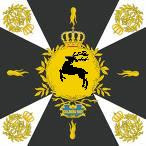All the last posts were a bit dry and technical, but I couldn't see any way round it, as the vocabulary is needed for any decent write-up of what each side is doing and why. Still, it's done now and I can progress. For the siege of Flussburg, I actually had a rough plan - I'd sketched a star-fort on the map I'd used for the approach marches to the battle near Flussburg, and so have adapted that for the design. The fortress is an eight-bastioned layout, of which half will need to be modelled for a decent game. On paper then, this would produce a semi-circle with three full bastions, two half-bastions right at the board edge, and four ravelins in between them.
My Plan 'Template' on paper

The finished fortress quarter (No. 2 on the way)

A plan view of the defences

The bastions and ravelins

The ditch and covered way

After dismissing built-up card covered in paper-mache, I built the models by buying a bunch of polystyrene insulation tiles and cutting into them - as the fortresses were supposedly low-lying, modelling them downwards into a surface rather than up above it seemed more sensible. I cut the tiles in half, marked one up with a paper template measuring about 24cm or 6BW from bastion-to-bastion. Using a sharp knife I cut out the ditch shape, then built up the covered way with corrugated cardboard strips glued together. Ravelin shapes were cut from the spare polystyrene removed to make the ditch. The cut sections were then glued down on the other unmarked half of the tile, which acted as a nice base for it all. Now I just need to paint it all...
Checking through the depleted force lists and OoB's after the battle of Althirschburg, the two forces have an infantry balance of around five-to-one in favour of the besieging Luftburg army - pretty good odds for a siege. Artillery-wise, the two sides are pretty equal, but as the siege is scheduled to run for 2 months I'm prepared to bolster the Luftburg artillery park a bit around the half-way point, maybe with some mortars. Scale will all be a bit relative. I estimate the defender of this mighty citadel will need about 20+ figures to do so, which means that the attackers will number a corresponding 100+ infantry bases. This can't be done all at once, but I'm planning to keep a tally on paper, and release troops to the tabletop as required.


5 comments:
A very neat model. I'm looking forward to seeing photos of the final result.
I have always want be build a model like yours, but lacked the confidence. Thanks for the suggestions and great pictures. Can't wait to see the final product. Thanks again...Bill
That is going to be one cool looking fortress when you're done! When combined with the fieldworks that Steve the Wargamer has over on his site, a very impressive set of seige scenarios can be conducted. Will the town's defenses be modular in nature, so that the breeches of the opposition's artillery can be shown as the seige wears on?
Hi Martin,
My plan at present is merely to create two tiles of 'quarter circles' which can be placed side by side to make half of the fortress. I was also pondering making a 'slope of rubble' to represent the breech, once it's made.
I'm not sure about future plans, but as the initial fort tiles proved easier than I had feared, I may ponder doing more.
Ta,
C
Nice looking models; look forward to seeing them completed and 'under siege'.
-- Allan
Post a Comment